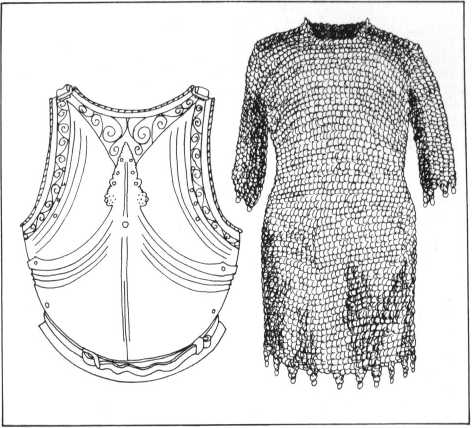m1365
characteristic of German infantry. (Carving of ‘Guards at Christ’s Tomb’, c.1345, Musee de l’Oeuvre Notre Damę, Strasbourg; frescoes, Castle of Sabbionara, Avio.)
Cy: English bowman, mid-i4th century This man is a veteran of the Hundred Years War and his heavy buff łeather jerkin still shows the stitch marks of the Cross of St. George which identified English soldiers. His helmet is a simple structure of smali metal plates sewn to a leather cap. His bow, unstrung and protected from the weather in a canvas bag, and the bracer on his left wrist are typical of a long-bow archer. F or personal protection he carries a smali buckler of perhaps Welsh origin and a heavy, single-edgedj/a/c/now. (‘Luttrell Psalter’, English manuscript, c.1340, British Library, London; ‘Chronicie of St. Denis’, French manuscript, second half of the 14A century, British Library, London; ‘Walter de Milemete’, English manuscript, 1326, Christ Church Lib., Oxford.)
D: The Yipers of Milan Di: Lombard knight, late 1 Ąth century Italian armour was now entering its golden age, with the work of Milanese armourers in demand throughout Europę. This knight wears a bascinet with a hounskull visor, while his mail aventail has a decorative cloth covering. Whereas in France armour was often worn beneath a voluminous tunic with puffed sleeves, Italians generally left their armour uncovered. Our knight has a breast-plate held in place by straps across his back, but wears no back-plate. (Milanese armour, c. 1385, Churburg Castle; efhgy of Jacopo Cavalli, c. 1398, SS Giovanni e Paolo, Venice; chased silver altar, 1371, Pistoia Cathedral.)
D2: North Italian hand-gunner, late ifh century Firearms appeared early in Italy and had greater impact than elsewhere. Primitive hand-guns were important in defending the cities where such weapons, produced in large numbers, could be issued to barely trained militias. This citizen wears his town’s colours and has a simple chapel-de-fer helmet as his only protection. (Chased silver altar, 1371, Pistoia Cathedral; fresco, 1365, Santa Maria Novella, Florence.)

left This breastplate, which originally belonged to Bar-tolomeo Colleoni, dates from the mid-i5th century and is in the Gothic style despite having been madę in Italy. (Waffen-sammlung, Vienna) right Mail shirt from Sinigaglia near Bologna. Its rings are mixed, some whole, some riveted, and are very large. This suggests an early i4th century datę, although the vandyked lower border suggests a later fashion. (Royal Scottish Museum, Edinburgh)
Dy: Italian heavy infantry, late i4th century Professional foot-soldiers were a vital and well-eąuipped element in Italian condottieri armies. This man wields a glaive, a traditional weapon in Italy, and wears a south German bascinet with a klappoisier hinged at the brow. His body armour is probably of cuir-bouilli hardened leather, plus smaller metal plates, riveted to a decorative velvet covering. (‘Battle of Clavigo’, fresco, c. 1370, Oratorio di S. Giorgio, Padua, ‘Gallic Wars’, Italian manuscript, c.1390, Trivulzian Lib., Milan.)
E: Bracceschi and Sforgeschi Ei: Italian knight, c.1425
The 15th century was the true Age of Platę in the history of armour. This horseman need not have been a nobleman as many leading condottieri had humble origins. He is, however, clearly rich for he wears a Milanese armour of the finest ąuality. To this would be added an armet type of helmet. His spurs are very long, as was necessary when riding in a tali ‘peaked’ saddle. His dagger is of the rondel style. (Milanese armour, c.1425, Churburg Castle; effigy of an Italian knight, early 15th century, Louvre, Paris; ‘Annunciation’, fresco by Pisanello, c. 1425, San Fermo, Yerona.)
35
Wyszukiwarka
Podobne podstrony:
m145! War harness for a rider and horse, madę at Landshut, Germany in c.1475-85, and characteristic
16180 w25Q particularly charactcnstic of Iialy, Germany and the Ibenan peninsula. In Italy, for exam
gednap German DNA Profiling SpurenkommissionCertificate of the correct characterization of four stai
skanuj0172 „The basie characteristics of the match an organization achieves with its environment is
00246 !d6f6da4a401d8c9089d33a3b3c255f 248 Vander Wiel the probabilistic characteristics of run leng
00492 ?6e2520b4751ef0af46b1927e1edb46 499 Achieving Quality Results Through Blended Management that
skanuj0172 „The basie characteristics of the match an organization achieves with its environment is
img0 (2) X-Ray Characterization of NanomaterialsRoman Pielaszek1>2l Stanisław Gier lotka1*, Ewa
4 Tobie I. Characteristics of r-and K-strategy according to Pianka (1978) with data from Walter
Research Papers 1 Characteńzation of PF ńngs by the finite topology on duals of R
26COMPOSITE MATERIALS JPRS-UMS-92-003 16 March 1992 Calculation of the Adhesion Characteristics of a
c) the genetic character of landforms (valley terraces, subglacial channels,
więcej podobnych podstron